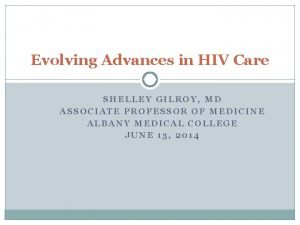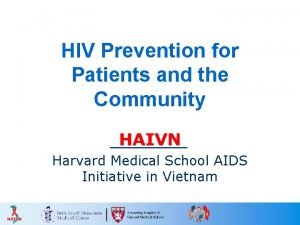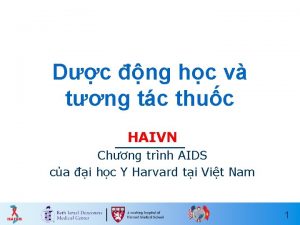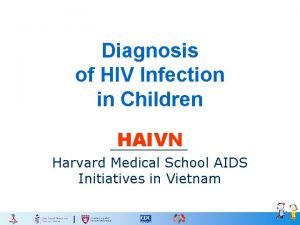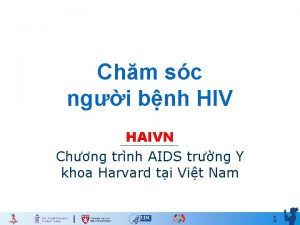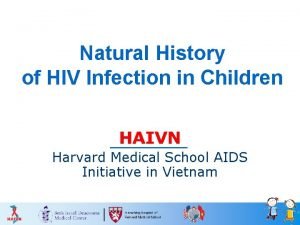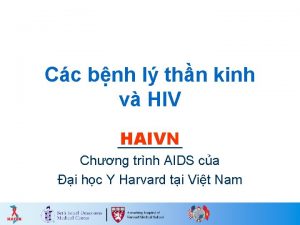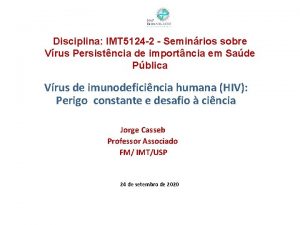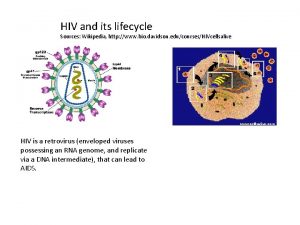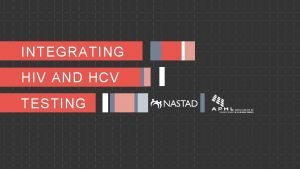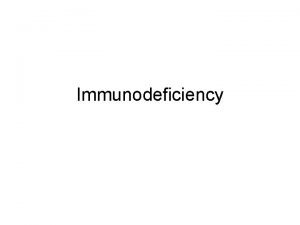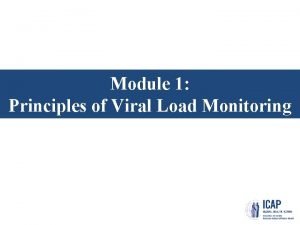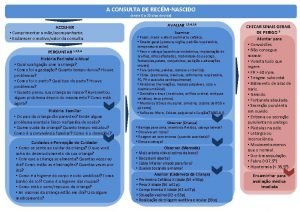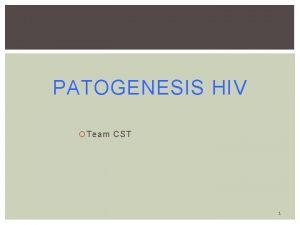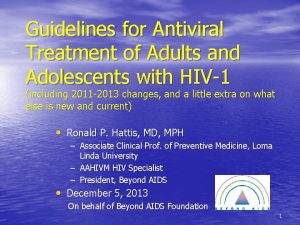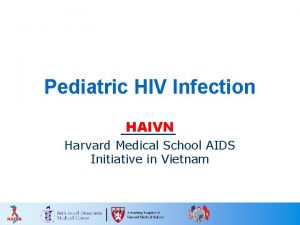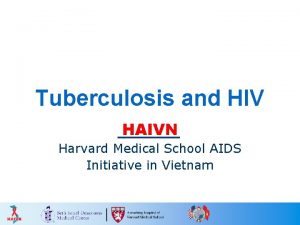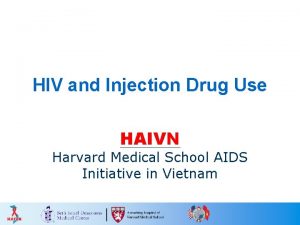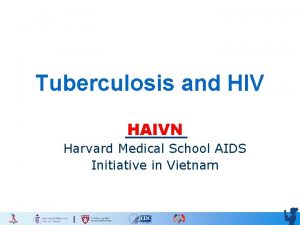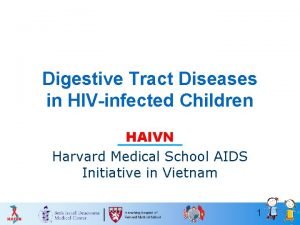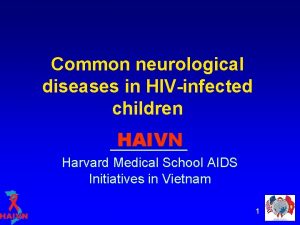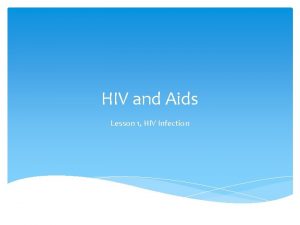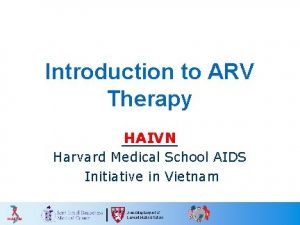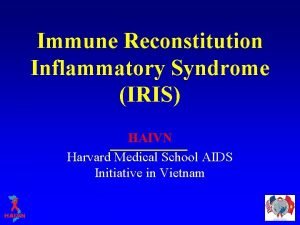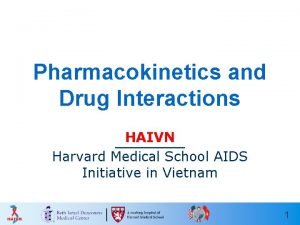Diagnosis of HIV Infection in Children HAIVN Harvard




















- Slides: 20

Diagnosis of HIV Infection in Children HAIVN Harvard Medical School AIDS Initiatives in Vietnam

Learning Objectives By the end of this session, participants should be able to: n Explain why early diagnosis of HIV in young children is important n Apply the algorithm of HIV diagnosis by age groups in diagnosing HIV in infants and children 2

Overview n n n In 2011, there were about 330 000 new HIV infection in children Mother-to-child transmission accounts for the majority of HIVinfection in children <15 years Diagnosis of HIV is challenging in infants in resource-limited countries 3

Why is Early Diagnosis Crucial ?

Early Diagnosis is Crucial (1) Early diagnosis of HIV helps to: n identify HIV infected children before they become symptomatic n allow healthcare providers to make appropriate care and treatment: • • Register at HIV OPC Assist on infant feeding Provide OI prophylaxis Prescribe ART 5

Early Diagnosis is Crucial (2) 18 months Newell ML et al. Mortality of infected and uninfected infants born to HIV-infected mothers in Africa: A pooled analysis. Lancet 2004; 364: 1236 -43.

Early Diagnosis in Children < 18 Months Old

Early HIV Diagnosis in Children <18 Months Old Diagnosis of HIV in this age group: n ELISA cannot be used as maternal antibodies are still present, rendering antibody-based testing for HIV unreliable n PCR can detect viral DNA/RNA directly and is the test of choice (which can be done at 4 -6 weeks of age) 8

Time Frame for PCR Presence of HIV antibodies (from mother) in HIV-exposed but un-infected children 6 weeks Early Diagnosis by PCR WHO Technical Publication No. 51: Management of HIV infection in infants and children: A clinical manual 2006.

Early Diagnosis Using Dried Blood Spot (DBS) n n n DBS is prepared by putting drops of blood on a piece of paper and allowing them to dry Can be stored and shipped to testing facilities at room air, over 3 -7 days PCR using DBS is as effective as PCR using liquid blood samples 10

HIV Diagnosis in Infants < 9 Months Old PCR with DBS at 4 -6 weeks of age If positive: n Initiate ARV treatment n Do 2 nd PCR for confirmation as soon as possible n Continue if breastfeeding If negative: n Wait until infant is 18 months old to perform ELISA for confirmation n Advise replacement feeding if possible 11

HIV Diagnosis in Infants between 9 -18 Months Old Perform HIV antibody test n If positive: • Follow PCR algorithm n If negative: • Infant is likely not HIV -infected 12

HIV Diagnosis in Infants < 18 Months Old and Suspected to Have HIV-antibody test If positive confirm diagnosis with PCR n If negative child does not have HIV n (if PCR not available, apply clinical criteria) 13

HIV diagnosis in infants < 18 months old n All children who have either: • first PCR negative • or second PCR negative will be confirmed the HIV status by ELISA tests at the age of 18 months 14

Case Studies

Clinical Diagnosis for Severe HIV/AIDS in Children < 18 Months (1) Apply clinical diagnostic criteria when virologic testing (PCR) is not available: HIV antibody positive + 1 clinical stage IV diagnosis or + At least 2 out of 3 1. Oral candidiasis 2. Severe bacterial pneumonia 3. Severe sepsis 16

Clinical Diagnosis of Severe HIV/AIDS in Children < 18 Months (2) Other factors assisting clinical diagnosis of severe HIV/AIDS disease: n Child born to a mother who: • has just died of HIV-related disease, or • has advanced HIV/AIDS disease n Child’s CD 4 percentage < 20% In these cases, definitive diagnosis with virological testing should be done as soon as possible. 17

HIV Diagnosis in Children > 18 Months n n Definitive diagnosis of HIV infection in children >18 months of age is based on HIV antibody test HIV infection is confirmed when the serum is positive with 3 tests using 3 different bioproducts 18

Key Points n n n Early diagnosis allows healthcare providers to make appropriate care and treatment In exposed children <18 months, HIV infection should be confirmed as early as possible using PCR Clinical diagnosis of severe HIV/AIDS in infants should be considered if HIV is suspected 19

Thank you! Questions?
 Hiv diagnosis algorithm
Hiv diagnosis algorithm What is receptive vaginal sex
What is receptive vaginal sex Haivn
Haivn Haivn
Haivn Haivn
Haivn Risk of receiving unprotected oral
Risk of receiving unprotected oral Haivn
Haivn Objectives of nursing process
Objectives of nursing process 5 phases of the nursing process
5 phases of the nursing process Perbedaan diagnosis gizi dan diagnosis medis
Perbedaan diagnosis gizi dan diagnosis medis Medical diagnosis and nursing diagnosis difference
Medical diagnosis and nursing diagnosis difference Medical diagnosis and nursing diagnosis difference
Medical diagnosis and nursing diagnosis difference Ciclo do hiv
Ciclo do hiv Viral integration
Viral integration Window period hiv
Window period hiv Hiv
Hiv Hiv transmissions
Hiv transmissions Hiv patologia
Hiv patologia Pola progresi penyakit typical progressor berlangsung mulai
Pola progresi penyakit typical progressor berlangsung mulai Hiv lifecycle
Hiv lifecycle Brainpop
Brainpop
